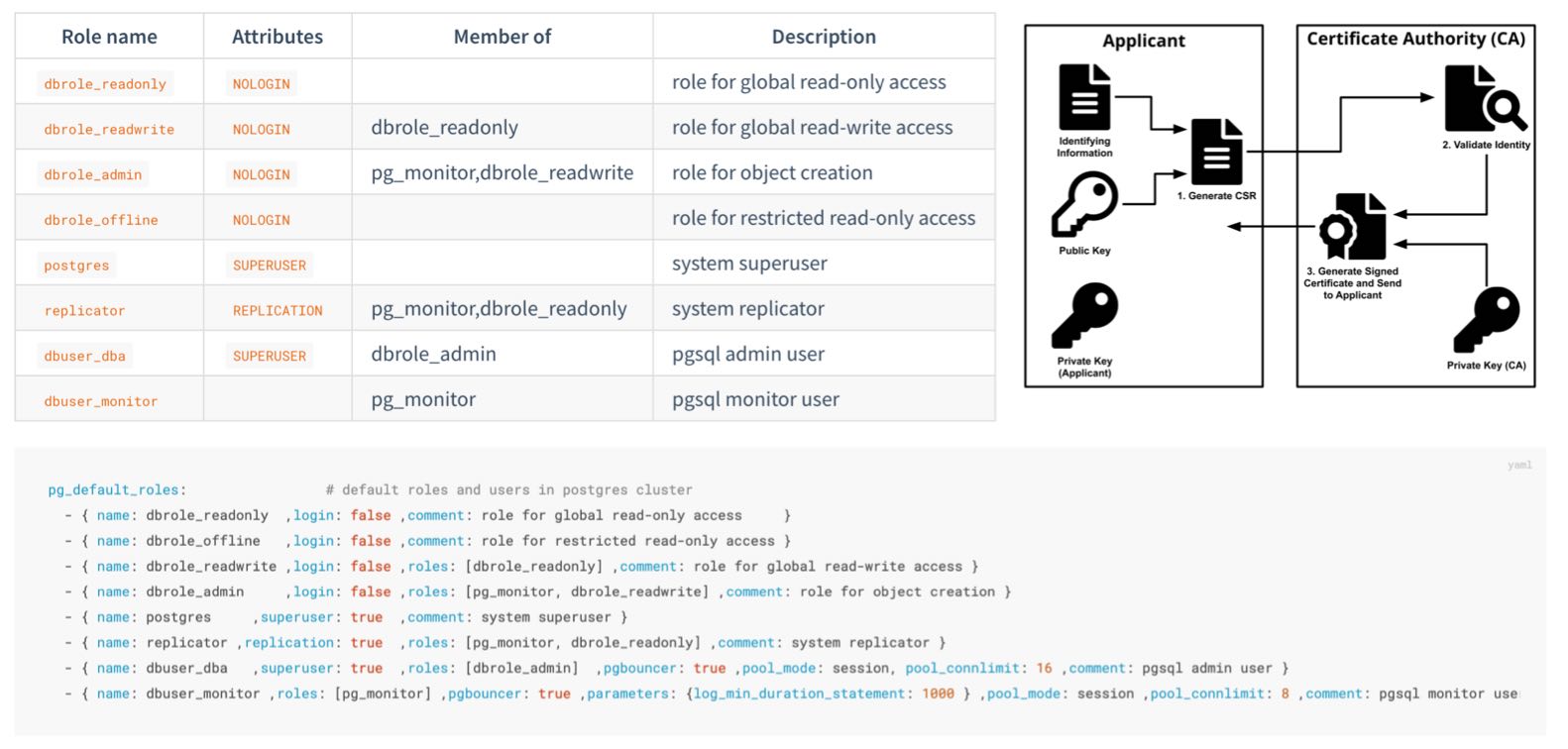Security
Module:
Categories:
Pigsty already provides a secure-by-default authentication and access control model, which is sufficient for most scenarios.
But if you want to further strengthen the security of the system, the following suggestions are for your reference:
Confidentiality
Important Files
Secure your pigsty config inventory
pigsty.ymlhas highly sensitive information, including passwords, certificates, and keys.- You should limit access to admin/infra nodes, only accessible by the admin/dba users
- Limit access to the git repo, if you are using git to manage your pigsty source.
Secure your CA private key and other certs
- These files are very important, and will be generated under
files/pkiunder pigsty source dir by default. - You should secure & backup them in a safe place periodically.
Passwords
Always change these passwords, DO NOT USE THE DEFAULT VALUES:
grafana_admin_password:pigstypg_admin_password:DBUser.DBApg_monitor_password:DBUser.Monitorpg_replication_password:DBUser.Replicatorpatroni_password:Patroni.APIhaproxy_admin_password:pigstyminio_secret_key:minioadmin
Please change MinIO user secret key and pgbackrest_repo references
- Please change the password for
minio_users.[pgbacrest].secret_key - Please change pgbackrest references:
pgbackrest_repo.minio.s3_key_secret
If you are using remote backup method, secure backup with distinct passwords
- Use
aes-256-cbcforpgbackrest_repo.*.cipher_type - When setting a password, you can use
${pg_cluster}placeholder as part of the password to avoid using the same password.
Use advanced password encryption method for PostgreSQL
- use
pg_pwd_encdefaultscram-sha-256instead of legacymd5
Enforce a strong pg password with the passwordcheck extension.
- add
$lib/passwordchecktopg_libsto enforce password policy.
Encrypt remote backup with an encryption algorithm
- check
pgbackrest_repodefinitionrepo_cipher_type
Add an expiration date to biz user passwords.
-
You can set an expiry date for each user for compliance purposes.
-
Don’t forget to refresh these passwords periodically.
- { name: dbuser_meta , password: Pleas3-ChangeThisPwd ,expire_in: 7300 ,pgbouncer: true ,roles: [ dbrole_admin ] ,comment: pigsty admin user } - { name: dbuser_view , password: Make.3ure-Compl1ance ,expire_in: 7300 ,pgbouncer: true ,roles: [ dbrole_readonly ] ,comment: read-only viewer for meta database } - { name: postgres ,superuser: true ,expire_in: 7300 ,comment: system superuser } - { name: replicator ,replication: true ,expire_in: 7300 ,roles: [pg_monitor, dbrole_readonly] ,comment: system replicator } - { name: dbuser_dba ,superuser: true ,expire_in: 7300 ,roles: [dbrole_admin] ,pgbouncer: true ,pool_mode: session, pool_connlimit: 16 , comment: pgsql admin user } - { name: dbuser_monitor ,roles: [pg_monitor] ,expire_in: 7300 ,pgbouncer: true ,parameters: {log_min_duration_statement: 1000 } ,pool_mode: session ,pool_connlimit: 8 ,comment: pgsql monitor user }
Do not log changing password statement into postgres log.
SET log_statement TO 'none';
ALTER USER "{{ user.name }}" PASSWORD '{{ user.password }}';
SET log_statement TO DEFAULT;
IP Addresses
Bind to specific IP addresses rather than all addresses for postgres/pgbouncer/patroni
- The default
pg_listenaddress is0.0.0.0, which is all IPv4 addresses. - consider using
pg_listen: '${ip},${vip},${lo}'to bind to specific addresses for better security.
Do not expose any port to the Internet; except 80/443, the infra portal
- Grafana/Prometheus are bind to all IP address by default for convenience.
- You can modify their bind configuration to listen on localhost/intranet IP and expose by Nginx.
- Redis server are bind to all IP address by default for convenience. You can change
redis_bind_addressto listen on intranet IP. - You can also implement it with the security group or firewall rules.
Limit postgres client access with HBA
- There’s a security enhance config template:
security.yml
Limit patroni admin access from the infra/admin node.
- This is restricted by default with
restapi.allowlist
Network Traffic
-
Access Nginx with SSL and domain names
- Nginx SSL is controlled by
nginx_sslmode, which isenableby default. - Nginx Domain names are specified by
infra_portal.<value>.domain.
- Nginx SSL is controlled by
-
Secure Patroni REST API with SSL
patroni_ssl_enabledis disabled by default- Since it affects health checks and API invocation.
- Note this is a global option, and you have to decide before deployment.
-
Secure Pgbouncer Client Traffic with SSL
pgbouncer_sslmodeisdisableby default- Since it has a significant performance impact.
Integrity
Consistency
Use consistency-first mode for PostgreSQL.
- Use
crit.ymltemplates forpg_confwill trade some availability for the best consistency.
Use node crit tuned template for better consistency
- set
node_tunetocritto reduce dirty page ratio.
- Enable data checksum to detect silent data corruption.
pg_checksumis disabled by default, and enabled forcrit.ymlby default- This can be enabled later, which requires a full cluster scan/stop.
Audit
- Enable
log_connectionsandlog_disconnectionsafter the pg cluster bootstrap.- Audit incoming sessions; this is enabled in
crit.ymlby default.
- Audit incoming sessions; this is enabled in
Availability
-
Do not access the database directly via a fixed IP address; use VIP, DNS, HAProxy, or their combination.
- Haproxy will handle the traffic control for the clients in case of failover/switchover.
-
Use enough nodes for serious production deployment.
- You need at least three nodes (tolerate one node failure) to achieve production-grade high availability.
- If you only have two nodes, you can tolerate the failure of the specific standby node.
- If you have one node, use an external S3/MinIO for cold backup & wal archive storage.
-
Trade off between availability and consistency for PostgreSQL.
-
Use multiple infra nodes in serious production deployment (e.g., 1~3)
- Usually, 2 ~ 3 is enough for a large production deployment.
-
Use enough etcd members and use even numbers (1,3,5,7).
- Check ETCD Configuration for details.
Feedback
Was this page helpful?
Glad to hear it! Please tell us how we can improve.
Sorry to hear that. Please tell us how we can improve.
